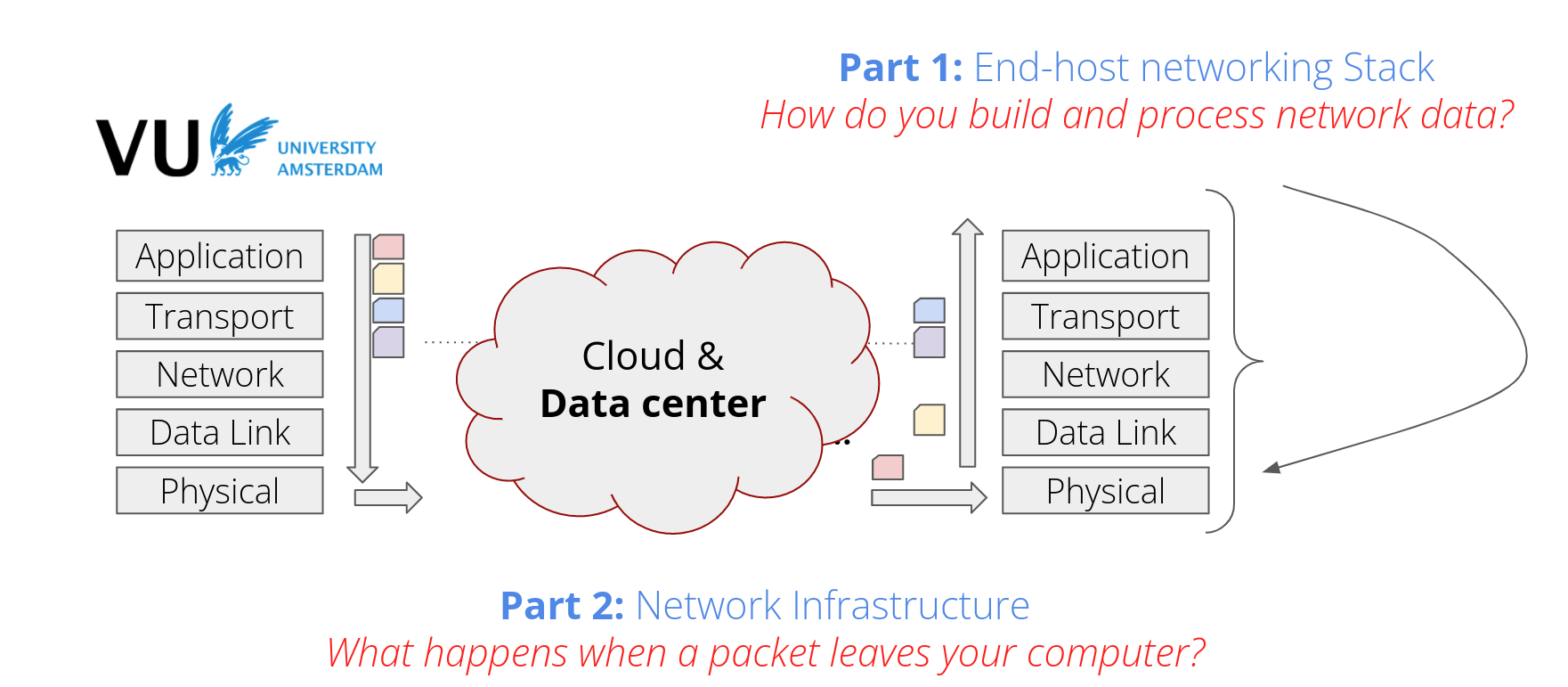Advanced Network Programming Homepage (XB_0048)
In our deeply interconnected world, many details of networking may appear cryptic to its users. In Sep-Oct 2020, together with Lin Wang, I designed and gave a new course called Advanced Network Programming for BSc. final year students at VU Amsterdam. Advanced Network Programming (ANP) course is aimed at teaching students about the recent networking research (research-oriented teaching) in general-purpose cloud computing. At the same time with the practical work, students are trained in state-of-the-practice networking tools used in everyday Linux networking stack (tcpdump, ping, traceroute, arping, netcat).
 Figure 1: Topics covered in ANP course
Figure 1: Topics covered in ANP course
Lecture slides
Advanced Network Programming (ANP) (VU catalogue) is a BSc-level course. The goal of the course is to (i) make students aware of the internals of end-host and data center networking advancements; (ii) show practical tools to debug and analyze the Linux stack; (iii) teach low-level nitty and gritty details by implementing network protocols. We cover the following topics (2021, Animesh covers lecture 1-6, Lin covers lectures 7-11):
- Introduction: Evolution of socket, DMA, Interrupt storms, SGE capabilities.
- Networking Concepts: MTU, Segmentation, stateful and stateless Offloading.
- Linux Internals: NAPI, SoftIRQs, SKB, rx/tx paths, zcopy stacks.
- Multicore Networking: Interrupt balancing, multi-queue NICs, RSS, RPS, XFS, MegaPipe.
- Userspace Stacks: Packet processing, Netmap, DPDK, mTCP.
- RDMA Networking: RDMA networking, low-latency networking, history.
- Network Forwarding and Routing: Switching, STP, VLAN, IP forwarding, Router architecture.
- Software Defined Networking: SDN, OpenFlow, Network virtualization, FlowVisor.
- Programmable Data Plane: Introduction to programmable switches (PISA) and P4 language.
- Cloud Networking: Datacenter topologies, Fat tree, PortLand, Google’s cloud networking.
- Beyond Networking: Video streaming internals, CBR, ABR, RTP, DASH, AWStream.
Editable versions of slides 1-6 are available here https://drive.google.com/drive/folders/1bnbdM4PWpd4khDjaApou0ZYL-rOBsY4b?usp=sharing. Others to follow soon…
Practical Work
In the course project students develop a working TCP/IP protocol in the userspace. The project consists of five key milestones:
- Welcome to the machine: setup the coding infrastructure and familarize yourself with Linux networking tools (tcpdump, ping, traceroute, arping, netcat) and RFC 793.
- Is anyone out there?: implement the ARP protocol and resolve IP addresses to mac addresses.
- Hey you: implement socket(), connect() calls with the TCP three-way handshake
- Careful With That Data, Eugene: implment send(), recv(), and close() calls with acknowledgements, retransmission, timeouts.
- Navigating Through the Fog: implement packet drop, retransmission, and routing using P4 and run end-to-end tests with the ANP TCP stack.
Drop me an email if you want access to more project related resources.
License
This course content are distributed under the Creative Commons Attribution 4.0 International (CC BY 4.0), https://creativecommons.org/licenses/by/4.0/